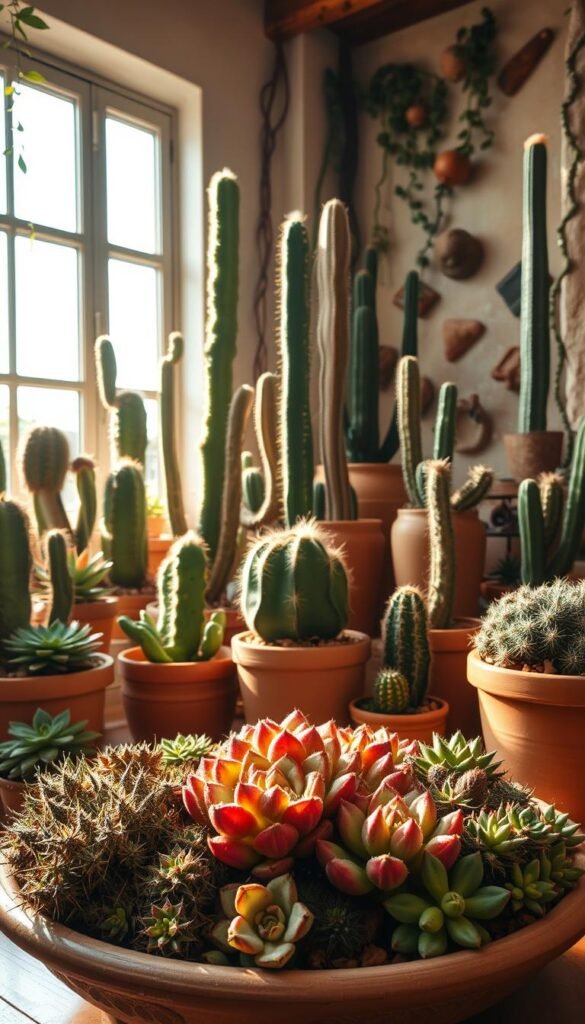Imagine transforming your home with a vibrant cluster of spiky textures and sculptural shapes that thrive with minimal effort. Multi-plant containers, often called cactus bowls, let you craft captivating displays that mirror the rugged beauty of arid regions. These living arrangements have surged in popularity as urban dwellers seek nature-inspired decor that fits modern lifestyles.
What makes these creations so appealing? They combine low-maintenance care with endless design flexibility. Unlike fast-growing plants, their slow expansion means your arrangement stays visually balanced for months. Just provide bright light and water sparingly – perfect for busy plant lovers or those new to indoor gardening.
Beyond their visual appeal, working with these resilient specimens offers therapeutic benefits. The process of selecting complementary shapes and sizes becomes a creative meditation. Finished pieces serve as striking focal points that spark conversations, whether displayed on office desks or dining tables.
Ready to explore how these drought-tolerant wonders can elevate your space? We’ll guide you through crafting a personalized display that thrives in your indoor environment while capturing that warm, earthy desert charm.
Essential Tools and Materials for Your Indoor Cactus Garden
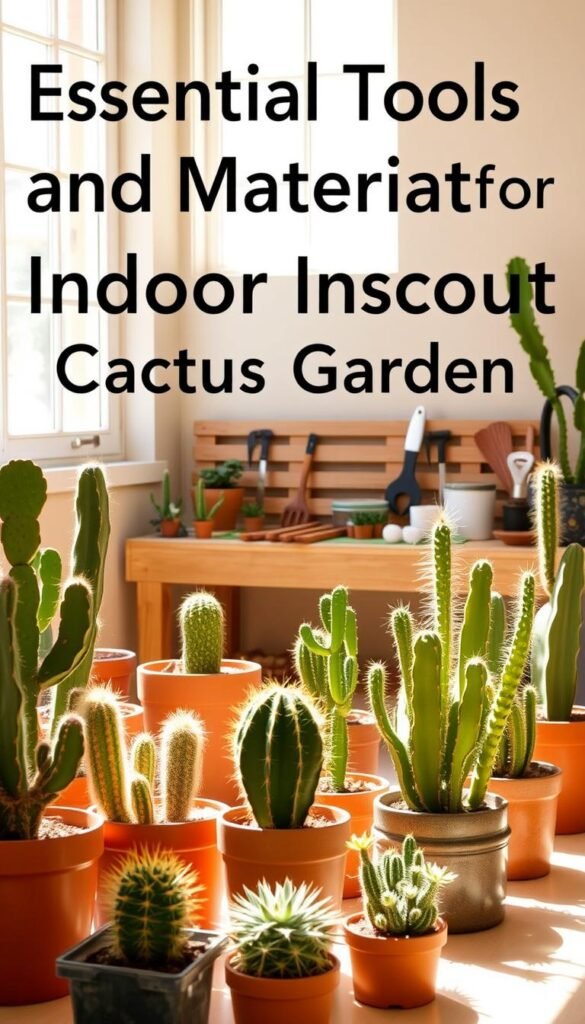
Creating a thriving spiky display starts with smart material choices. Let’s explore how to pick plants and containers that ensure long-term success while matching your style.
Selecting the Right Cacti and Succulents
Begin with 2″-4″ nursery-grown specimens for easy handling. Look for slow-growing types like Mammillaria or Echeveria that maintain their shape. Pair tall columnar varieties with rosette-shaped succulents for contrast.
Choosing Containers and Soil Mix for Optimal Drainage
Shallow pots (2.5″-6″ deep) prevent waterlogging. Terra cotta and unglazed ceramic allow roots to breathe – crucial for preventing rot. Always verify drainage holes; add extra in wide containers using a drill.
| Material | Drainage | Weight | Best For |
|---|---|---|---|
| Terra Cotta | Excellent | Medium | Small arrangements |
| Ceramic | Good | Heavy | Statement pieces |
| Concrete | Moderate | Very Heavy | Outdoor transitions |
Use a gritty soil mix containing perlite and coarse sand. Avoid moisture-retentive blends – they’re the top cause of root issues. For container ideas, explore our guide on right containers tailored to specific plant needs.
Cactus Dish Garden Tutorials: Bring the Desert Vibe Indoors – Step-by-Step Planting Guide
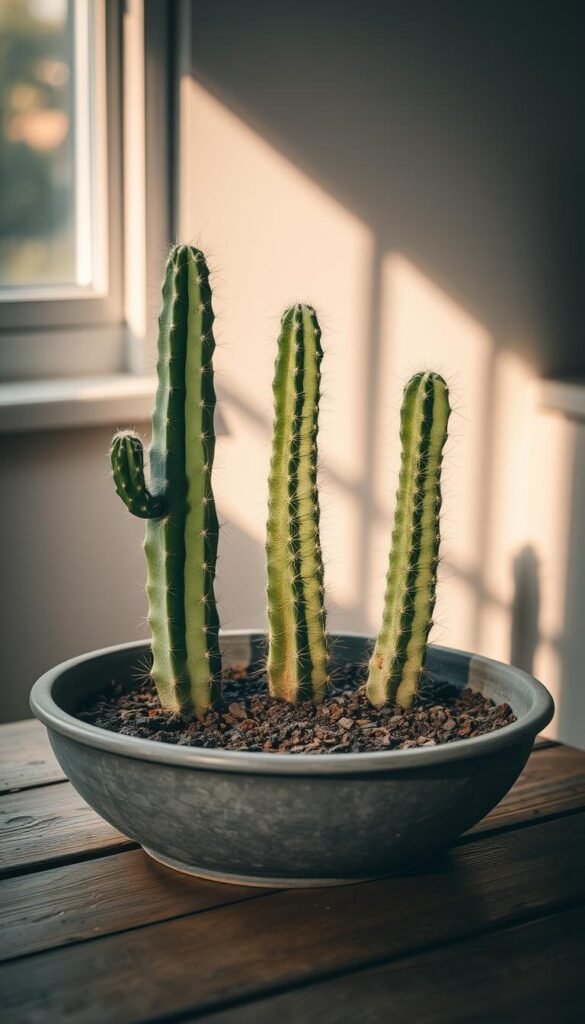
Spring through early fall offers the ideal window to build your spiky masterpiece. With simple tools and strategic layering, you’ll create a stable foundation for long-term growth. Let’s transform that empty shallow container into a thriving miniature landscape.
Preparing Your Shallow Container and Potting Mix
Start by filling the pot one-third full with gritty cactus soil mix. Add a ½” gravel layer at the bottom for drainage – this prevents soggy roots. Leave 1″ space below the rim for plants and decorative toppings.
Layering, Positioning, and Planting Your Cacti
Grip spiky specimens with kitchen tongs wrapped in microfiber cloths. Arrange them like puzzle pieces – tall varieties at the back, trailing types near edges. Use metal chopsticks to tweak positions without scratching surfaces.
“Plant each specimen so its base sits level with the soil surface,” advises veteran gardeners. Firm the mix around roots, leaving air pockets for breathability. Finish by tapping the container gently to settle everything in place.
Need to refresh an existing arrangement? Our guide to repotting techniques shows how to upgrade your display safely. Remember – patience pays off when working with these slow-growing beauties!
Indoor Environment and Care Strategies for Your Cactus Arrangement
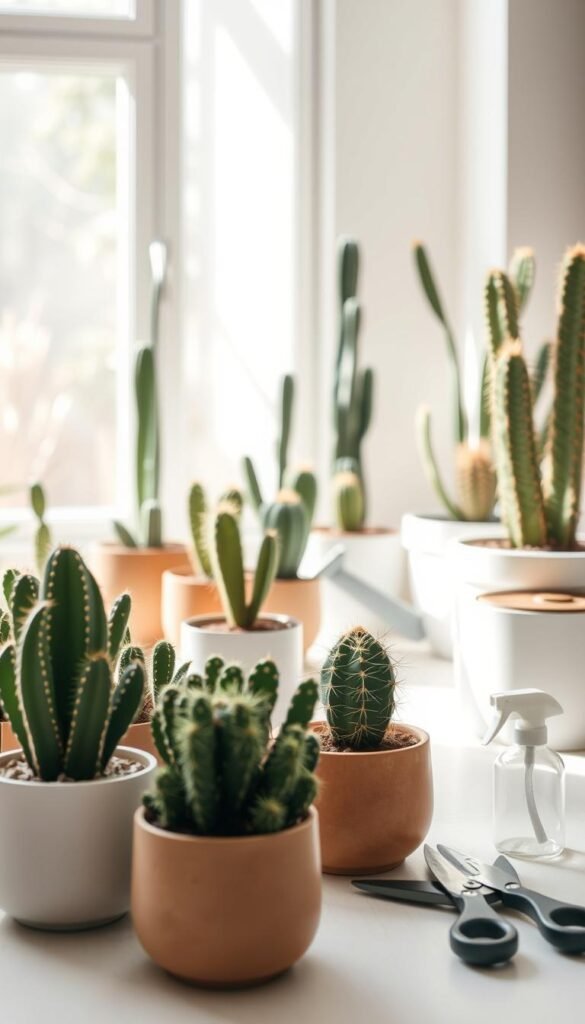
Nurturing your spiky companions requires mastering two key elements: strategic light placement and mindful hydration habits. These elements work together to create a thriving miniature landscape that outshines typical houseplants in both style and simplicity.
Lighting Considerations and Placement Tips
Find a bright spot receiving 4-6 hours of indirect sunlight daily. East-facing windows often work best, offering gentle morning rays without harsh afternoon glare. Rotate your arrangement weekly to prevent lopsided growth – a common issue with fixed light sources.
Watch for color changes. Yellowing suggests too much direct sun, while stretched-out shapes indicate insufficient light. If natural light’s limited, position LED grow lights 12″ above the display for 8-10 hours daily.
Watering Routine and Seasonal Care Best Practices
Wait 7 days after planting before your first watering. This rest period lets roots recover from handling. When it’s time, use a narrow-spout bottle to moisten soil evenly without wetting plant bodies.
Adjust frequency seasonally: every 2-3 weeks in summer, stretching to 5 weeks in winter. Always check soil dryness by inserting a chopstick – if it comes out clean, water thoroughly. Remember: shallow containers dry faster than deep pots!
During colder months, reduce hydration by half. Most varieties enter dormancy, making overwatering the top threat. Pair this adjusted schedule with cooler room temperatures (55-65°F) for optimal health.
Creative Decorating Ideas for a Unique Desert Spotlight
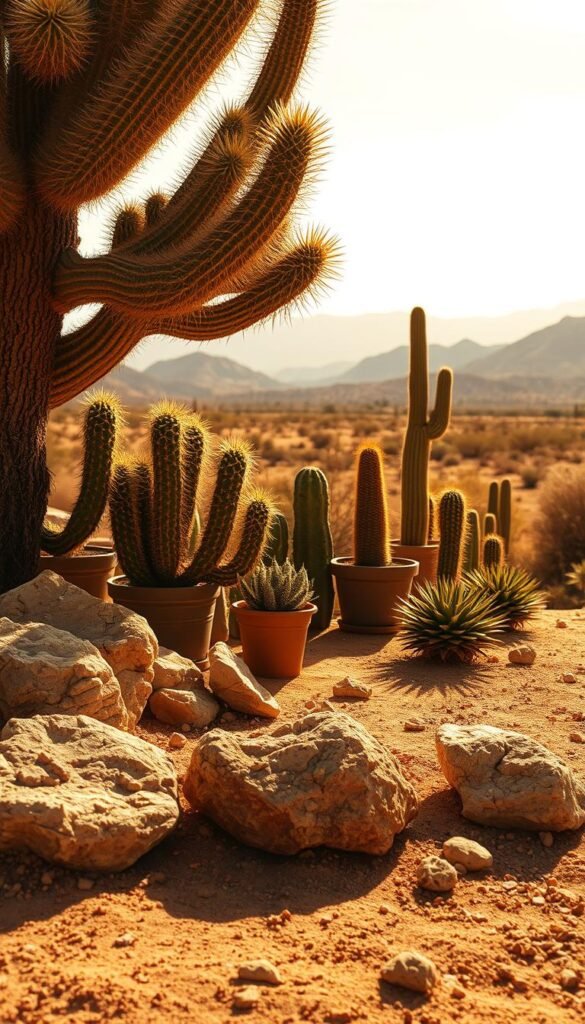
Transform your spiky display into a personalized work of art using nature’s jewelry box. The right finishing touches turn functional containers into eye-catching conversation starters that celebrate arid landscapes.
Enhancing with Topdressing, Stones, and Decorative Elements
Start with a thin layer of materials that mimic natural desert floors. Crushed glass chips sparkle like morning dew, while red sandstone grit adds warm earth tones. Keep decorative toppings under ¼” thick – enough to cover soil without trapping moisture.
Create focal points with chunky quartz crystals or smooth river rocks. Place these near your tallest plant or off-center for visual balance. “Let your toppings frame the plants, not compete with them,” suggests Phoenix-based designer Lara Kline. Pair blue-gray slate pieces with green succulents for cool contrast.
Seasonal updates keep arrangements fresh. Swap white winter sand for amber summer gravel, or add miniature holiday-themed accents. Always leave 30% of the soil surface uncovered to let it breathe. For bowl-shaped displays, arrange toppings in concentric circles that draw the eye inward.
Complete your scene with tiny terracotta figurines or bleached driftwood shards. These additions should occupy less than 10% of the surface area – think subtle storytelling, not crowded dioramas. Your final creation will feel like a sunbaked mesa shrunk to tabletop size.
Final Reflections on Your Cactus Garden Journey
As you admire your thriving miniature desert, take pride in the living artwork you’ve cultivated. These resilient cacti and succulents teach patience through their slow growth, rewarding you with enduring beauty that evolves over time. Your journey blends creativity with practical skills—from mastering soil drainage and composition to perfecting seasonal watering routines.
Your arrangement isn’t just decor—it’s a wellness tool. Studies show caring for succulents reduces stress while improving indoor air quality. The techniques you’ve learned, like using narrow-spout bottles for precise hydration, apply to other houseplants too.
Consider expanding your collection with drought-tolerant varieties or eco-friendly containers made from repurposed pots. Share cuttings with friends—each new growth symbolizes your growing expertise.
Through cold winter months and sunny seasons, your spiky companions will thrive under mindful care. Ensure proper drainage to prevent root issues—these tips transform casual care into an art form. Watch as they become enduring symbols of earthy charm in your home, enriching your gardening journey for years ahead.

